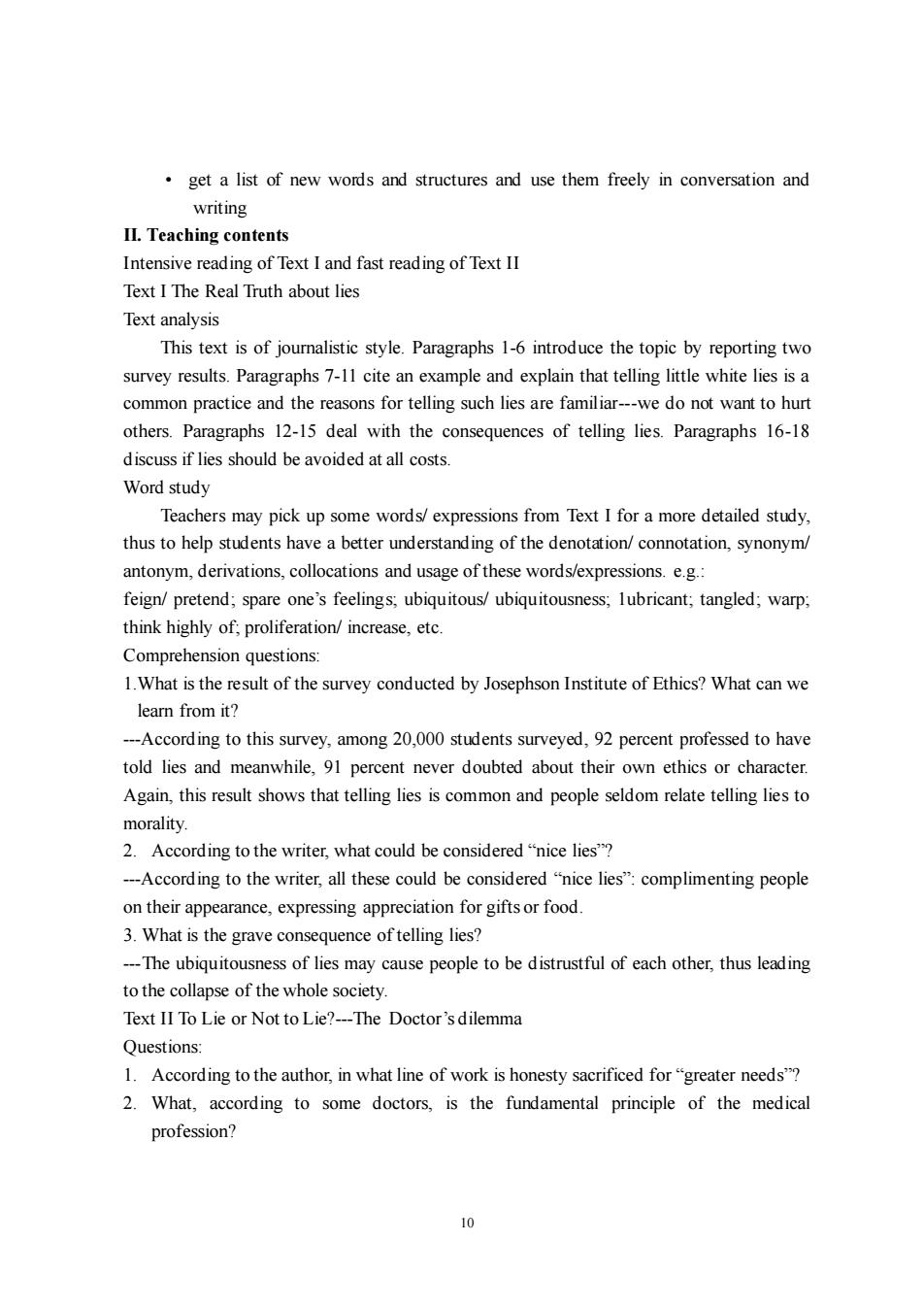正在加载图片...

get a list of new words and structures and use them freely in conversation and writing II.Teaching contents Intensive reading of Text I and fast reading of Text II Text I The Real Truth about lies Text analysis This text is of joumalistic style.Paragraphs 1-6 introduce the topic by reporting two survey results.Paragraphs 7-11 cite an example and explain that telling little white lies is a common practice and the reasons for telling such lies are familiar--we do not want to hurt others.Paragraphs 12-15 deal with the consequences of telling lies.Paragraphs 16-18 discuss if lies should be avoided at all costs. Word study Teachers may pick up some words/expressions from Text I for a more detailed study. thus to help students have a better understanding of the denotation/connotation,synonym/ antonym,derivations,collocations and usage of these words/expressions.e.g. feign/pretend;spare one's feelings;ubiquitous/ubiquitousness;lubricant;tangled;warp: think highly of proliferation/increase,etc Comprehension questions: .What is the result of the survey conducted by Josephson Institute of Ethics?What can we learn from it? -According to this survey.among 20,000 students surveyed,92 percent professed to have told lies and meanwhile,91 percent never doubted about their own ethics or character. Again,this result shows that telling lies is common and people seldom relate telling lies to morality. 2.According to the writer,what could be considered"nice lies"? --According to the writer,all these could be considered"nice lies":complimenting people on their appearance,expressing appreciation for gifts or food 3.What is the grave consequence oftelling lies? ---The ubiquitousness of lies may cause people to be distrustful of each other,thus leading to the collapse of the whole society. Text II To Lie or Not to Lie?--The Doctor'sdilemma Questions: 1.According to the author,in what line of work is honesty sacrificed for"greater needs"? 2.What,according to some doctors.is the fundamental principle of the medical profession? 1010 • get a list of new words and structures and use them freely in conversation and writing II. Teaching contents Intensive reading of Text I and fast reading of Text II Text I The Real Truth about lies Text analysis This text is of journalistic style. Paragraphs 1-6 introduce the topic by reporting two survey results. Paragraphs 7-11 cite an example and explain that telling little white lies is a common practice and the reasons for telling such lies are familiar---we do not want to hurt others. Paragraphs 12-15 deal with the consequences of telling lies. Paragraphs 16-18 discuss if lies should be avoided at all costs. Word study Teachers may pick up some words/ expressions from Text I for a more detailed study, thus to help students have a better understanding of the denotation/ connotation, synonym/ antonym, derivations, collocations and usage of these words/expressions. e.g.: feign/ pretend; spare one’s feelings; ubiquitous/ ubiquitousness; 1ubricant; tangled; warp; think highly of; proliferation/ increase, etc. Comprehension questions: 1.What is the result of the survey conducted by Josephson Institute of Ethics? What can we learn from it? ---According to this survey, among 20,000 students surveyed, 92 percent professed to have told lies and meanwhile, 91 percent never doubted about their own ethics or character. Again, this result shows that telling lies is common and people seldom relate telling lies to morality. 2. According to the writer, what could be considered “nice lies”? ---According to the writer, all these could be considered “nice lies”: complimenting people on their appearance, expressing appreciation for gifts or food. 3. What is the grave consequence of telling lies? ---The ubiquitousness of lies may cause people to be distrustful of each other, thus leading to the collapse of the whole society. Text II To Lie or Not to Lie?---The Doctor’s dilemma Questions: 1. According to the author, in what line of work is honesty sacrificed for “greater needs”? 2. What, according to some doctors, is the fundamental principle of the medical profession?